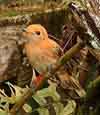Atiu also has a traditional name, Enuamanu, which means, land of the birds. When the first Polynesians arrived Atiu, must have been covered with birds. This is not quite the case today. Atiu's birds were plundered as food and decoration by the early polynesians. The Atiu community is now active in re-establishing Atiu place as the land of the birds in the Cook Islands and this activity has resulted in rapid increases in most species.
It is interesting to see how Atiu slipped from it's reputation as the "land of the birds". There are legends still told of how, by setting fire to the fern land, one could harvest cooked duck eggs. More recently the 12 gauge shot gun was brought to bear on Atiu's larger birds. As can be expected duck numbers rapidly fell. However they were not wiped out and now more conservative practices have seen their number increase again.
Another large bird, the pacific pigeon was also shot in large numbers but is now making a rapid comeback as more fruit tree varieties have been introduced and has increased the bird's food source. The pacific pigeon is now often seen eating the Java plum and the fruit of the Acacia Mangium both recently introduced and very abundant tree species. The bird is no longer shot.

Birdman George with "White-white a kakerori
released at Atiu Villas on Atiu in 2002
A red lorikeet was also once plentiful on Atiu. The Ariki and lesser chiefs once wore its red feathers as a signature for their rank. Cloaks were made of their feathers. The bird's feathers were still around when Captain Cook visited but are not today. The same bird still exists only on Rimatara in French Polynesia in large numbers but it is classified as endangered as the bird will be destroyed by the ship rat if the pest ever gets introduced to Rimatara. Atiu does not have the Ship Rat so on 24th April 2007 27 Red Lorikeets were released on Atiu. (click here for latest information)
In 2001, 10 Kakerori (Rarotongan Flycatcher) were released on Atiu as part of the recovery programme for the bird. The numbers of this bird on Rarotonga had dropped as low as 29 before a ship rat trapping programme brought numbers back from the brink. In 2001 there were more than 200 birds and Atiu was chosen as a home for a second colony. Atiu does not have the ship rat yet. In 2002 a further 10 birds and in August 2003 another 10 birds were released from the gardens of Atiu Villas. Check on the latest sightings

Two kura photographed by Chong Fasan on Rimatara
There are other birds of note. Both sea and land birds can be seen around the coast and in the jungle. The kopeka is Atiu's signature bird with a habit of never landing outside it's cave and then not even landing in it's cave but hanging upside down instead, like a bat. There is a special tour available to this cave that should not be missed. There are colourful fruit doves, kingfishers, plovers and hard to find crakes.
The nearby bird sanctuary of Takutea Island has many nesting seabirds and these birds often visit Atiu. If you are lucky that when you visit there is an expedition to this island, then you will have an experience you will never forget. The island is almost untouched by humans. The birds nest on the beach, in low trees and on the ground in the bush. They are almost tame.

Red-red the Kakerori
NOTE 29/12/2002 the first two Kakerori nestlings were sighted. It is the beginning of the next generation of Atiuan Kakerori.
NOTE 9/9/2003 a total of four fledglings found for the year 2002.
NOTE 4/10/2004 a total of ten fledglings found for the year 2003 and three pairs have taken up territory around Atiu Villas.
NOTE 9/4/2005 five fledglings so far found for the year 2004. This was a year noticable for the large number of New Zealand migratory long-tailed cookoos (kakerori predator) stopping on Atiu during the breeding season and 2 destructive cyclones immediately after the season.
NOTE 1/12/2006 two pairs of second generation Kakerori seen nesting. Red Lorikeet scheduled for release on Atiu in 2007.
NOTE 24/4/2007 27 Red Lorikeets from Rimatara released on Atiu to be known as "Kura".
NOTE 1/7/2007 4 kura sighted on the island of Mitiaro 40 km from Atiu.
NOTE 21/2/2008 first kura fledgling sighted.
NOTE 1/7/2008 first kura nest located and fledglings seen 25/8/2008.


